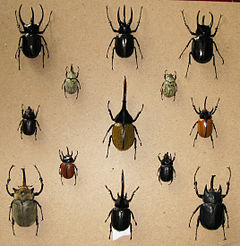Rhinoceros beetles
| Dynastinae | |
|---|---|
 |
|
| Scientific classification | |
| Kingdom: | Animalia |
| Phylum: | Arthropoda |
| Class: | Insecta |
| Order: | Coleoptera |
| Suborder: | Polyphaga |
| Infraorder: | Scarabaeiformia |
| Superfamily: | Scarabaeoidea |
| Family: | Scarabaeidae |
| Subfamily: |
Dynastinae MacLeay, 1819 |
| Tribes | |
|
6-8, see text |
|
6-8, see text
Dynastinae or rhinoceros beetles are a subfamily of the scarab beetle family (Scarabaeidae). Other common names – some for particular groups of rhinoceros beetles – are for example Hercules beetles, unicorn beetles or horn beetles. Over 300 species of rhinoceros beetles are known.
Many rhinoceros beetles are well known for their unique shapes and large sizes. Some famous species are, for example, the Atlas beetle (Chalcosoma atlas), common rhinoceros beetle (Xylotrupes ulysses), elephant beetle (Megasoma elephas), European rhinoceros beetle (Oryctes nasicornis), Hercules beetle (Dynastes hercules), Japanese rhinoceros beetle or kabutomushi (Allomyrina dichotoma), ox beetle (Strategus aloeus) and the Eastern Hercules beetle (Dynastes tityus).
The Dynastinae are among the largest of beetles, reaching more than 150 mm (6 in) in length, but are completely harmless to humans because they cannot bite or sting. Some species have been anecdotally claimed to lift up to 850 times their own weight. Their common names refer to the characteristic horns borne only by the males of most species in the group. Each has a horn on the head and another horn pointing forward from the center of the thorax. The horns are used in fighting other males during mating season, and for digging. The size of the horn is a good indicator of nutrition and physical health.
The body of an adult rhinoceros beetle is covered by a thick exoskeleton. A pair of thick wings lie atop another set of membranous wings underneath, allowing the rhinoceros beetle to fly, although not very efficiently, owing to its large size. Their best protection from predators is their size and stature. Additionally, since they are nocturnal, they avoid many of their predators during the day. When the sun is out, they hide under logs or in vegetation to camouflage themselves from the few predators big enough to want to eat them. If rhinoceros beetles are disturbed, some can release very loud, hissing squeaks. The hissing squeaks are created by rubbing their abdomens against the ends of their wing covers. Rhinoceros beetles are relatively resilient; a healthy adult male can live up to 2-3 years. The females rarely live long after they mate.
...
Wikipedia
